Kalanchoes are easy to care for and fun to collect. In this post, I’m going to teach you everything you’ll need to know about how to grow them both indoors and outside.

Kalanchoes are fun to collect, easy to grow, and can live for many years when give the proper care.
These versatile plants do great in containers or in the ground, and can thrive equally well houseplants or outside in the landscape.
They don’t require much attention, and there are literally hundreds of varieties to choose from – each unique in their own way.
In this complete guide, you’ll learn everything you need to know about kalanchoe plant care.
From basics like water, soil, light, and fertilizer, to tips for how to prune and propagate them. Soon you’ll be a pro at keeping any type thriving.
Information About Kalanchoes
Kalanchoes are perennial succulents native to the arid regions of Madagascar. They’re a durable plant that grows well indoors, or even outdoors depending on your climate.
There are over 100 species on the market these days. You’d probably recognize the most common flowering variety that is a popular gift plant.
The diverse appearances can bring lovely interest to your home or landscaping. Basically, no matter your tastes, whether you like smooth, scalloped, or multicolored foliage, there’s one for you.
Different Kalanchoe Varieties
There’s a huge number of kalanchoe varieties out there, and the size, color, and growth habits vary dramatically between them.
They are all so incredibly different. You’d probably have a hard time believing most of them are related! Here are some of the more popular ones…
- Kalanchoe blossfeldiana – This is the most well-known by far. It showcases four-petaled flower clusters on upright stems. They come in several vibrant colors like pink, red, yellow, orange, and white.
- Kalanchoe thyrsiflora – Also known as the ‘flapjack’ or ‘paddle plant’, it features wide circular, flat, green leaves that look like pancakes with red edges.
- Kalanchoe tomentosa – The ‘panda plant’ or ‘teddy bear’ variety is uniquely colored with pale and fuzzy grey-green foliage tipped with deep red or dark brown spots.
- Kalanchoe ‘Elk Antlers’ – Its growth is exactly how it sounds. The thin leaves branch out from a central stem with small offshoots to resemble the rack of an elk.
- Kalanchoe delagoensis (aka Mother of Millions) – This variety features lovely patterned foliage that grows in a crown with tall spikes of chandelier-shaped flower clusters. Its nickname comes from the dozens of plantlets that form on the leaf edges.
- Kalanchoe daigremontiana (Mother Of Thousands) – Often mistaken for the one above because of the similar characteristics, this one has green leaves that come to a point at the tips, and pinkish-orange blooms.
Flowers
Most types of kalanchoes get flowers, and some will even bloom constantly with the right care.
They have different bloom times, as well as various flower sizes, shapes, and colors, depending on the species.
Some get bell-shaped flowers that dangle down from the top of tall spikes. Others bolt and then die after blooming. While the most common one gets bright clusters of star-shaped blossoms.
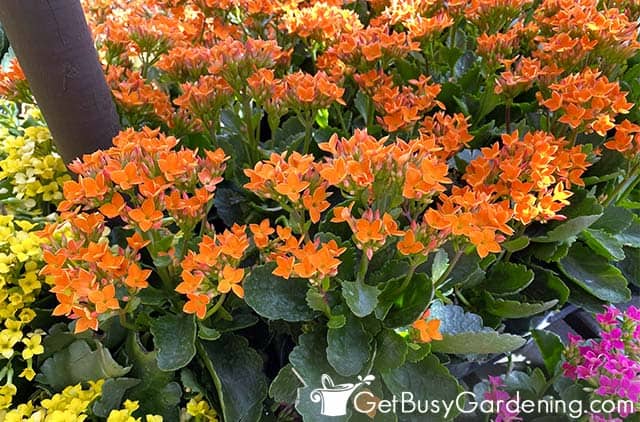
How To Grow Kalanchoe
Before we chat about how to care for kalanchoe, let’s first talk about where to grow them. Choosing the right spot is an important first step for long-lasting health.
Hardiness
Kalanchoe is not a cold hardy plant, but it is a perennial in zones 8-10. In those regions they’re commonly found in gardens or used as landscaping bedding plants.
If your climate gets colder than 40°F, keep them inside, that’s a bit too chilly for them.
But, when nightime temperatures rise above that, they can be moved outdoors to enjoy some summer weather.
All of the varieties are beautiful in containers, flowering or not, and many of them make excellent houseplants.
Where To Grow Kalanchoe
The best place to grow kalanchoe depends on the specific type you have and your location.
Outdoors, most will thrive in partial to full sun, but some will burn if it’s too intense. Be sure to choose a spot in the garden that has sandy, well-draining soil.
Indoors, they prefer bright indirect light most of the year. In the summer they can burn in very sunny windows, but prefer them in the winter.
They do very well in containers, but choose one with drainage holes to help prevent overwatering and root rot.
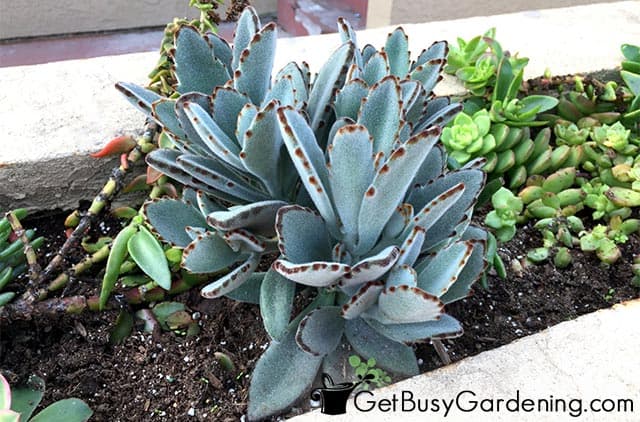
Kalanchoe Care & Growing Instructions
With the perfect spot in mind, it’s time to learn about kalanchoe care. With these tips you’ll know exactly how to keep yours thriving.
Light
Most types of kalanchoe plants likes lots of light. Many can tolerate the direct sun outside, but some will show signs of damage, like brown spotting, if exposed to the intense afternoon rays.
Indoors, choose a bright room or windowsill that gets plenty of natural light. Or, add a grow light to supplement if they start getting leggy.
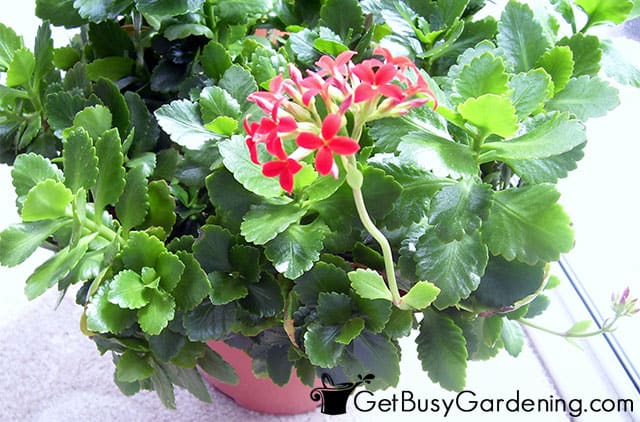
Water
Since their leaves are very good at storing water, they don’t need much. Overwatering is a common cause of poor health and root rot.
When the top inch of soil is dry to the touch, water thoroughly to moisten it, but don’t make it soggy. Always dump out any extra from the drainage tray.
Reduce watering in the winter so the soil dries almost completely. It’s especially important not to overwater if you’re trying to trigger flowering.
Investing in an inexpensive soil moisture gauge can be a handy tool if you struggle with that.
Related Post: When & How To Water Succulents
Fertilizer
Kalanchoes don’t need fertilizer as part of their regular care routine. But using a natural plant food occasionally can stimulate growth and encourage more robust flowering.
Outdoors, top dress them with organic granules or compost in the spring. Indoors, use a houseplant fertilizer once a month during the spring and summer to help it thrive.
Don’t fertilize at all in the fall and winter. Avoid using chemical brands, because they can damage and burn your plants.
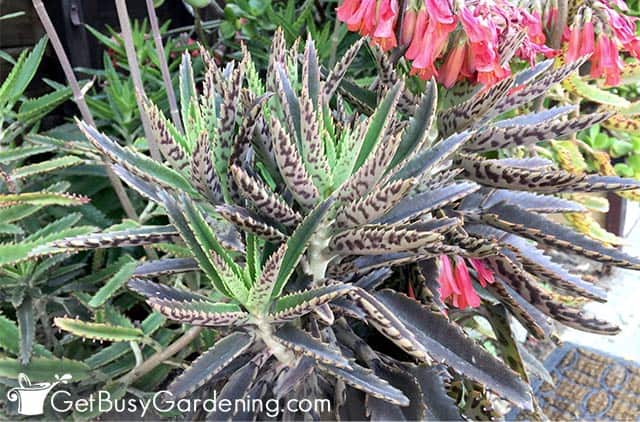
Soil
Natively, kalanchoes live in sandy, aerated soil. At home you can replicate that by using a well-draining mixture designed for cacti or succulents.
You can also try making your own by mixing equal parts of general potting soil with perlite and coarse sand.
Temperature
The ideal temperature range for growing kalanchoe is 40-80°F. If it gets colder than that, they can suffer and eventually die. Always bring them back inside before the first frost if they spend time outdoors.
If temperatures get much hotter, check the soil often to make sure they don’t need more frequent watering.
Repotting
Kalanchoe is slow-growing and typically will only need repotting every few years. When roots begin to peek out of the drainage holes, you’ll know it’s time to size up.
Tackle it in the spring, or right after flowering. Plant it at the same depth in a container 1-2” larger. Pack the soil gently around it, and water until moist, but not soggy.
If yours hasn’t been repotted in a couple of years, it’s a good idea to add nutrients to the soil with granular fertilizer, or compost outdoors.
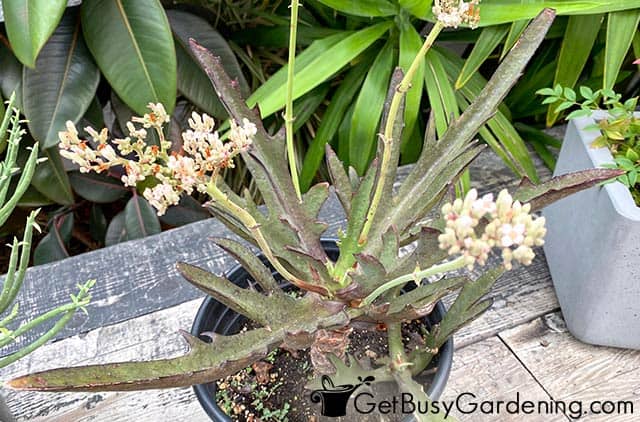
Pruning
Pruning is an important part of kalanchoe care. Deadheading spent flowers, pinching stem tips, and removing dead leaves keeps them healthy, and encourages a more compact form.
Use sharp, sterile pruners or precision shears to trim off spent flowers or leggy foliage in the spring and summer.
Pest Control Tips
Healthy kalanchoe rarely have issues with pests, especially indoors. But from time to time mealybugs, aphids, or scale insects can become a problem.
Thankfully, all of them can be treated naturally with neem oil, organic insecticidal soap, or removing them with rubbing alcohol.
To make your own insecticidal spray combine 1 teaspoon of mild liquid soap with 1 liter of water. Be sure to test any pest control method on a few leaves before treating the whole plant.
Kalanchoe Propagation Tips
Kalanchoes are very easy to propagate either by rooting cuttings or by division. Some species produce little plantlets that can be rooted, while for others you’ll need to take stem cuttings.
For cuttings, take a healthy segment of stem a few inches long with sharp, sterile snips, and let it callous over for a few days. Then dust the cut end with rooting hormone, and place it into well-draining soil.
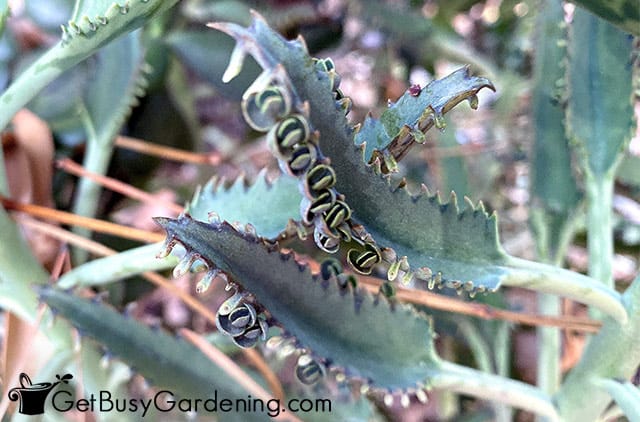
Troubleshooting Common Kalanchoe Problems
Kalanchoes are sturdy plants that are fairly easy to care for. But, over the years you might run into the occasional issue. Here are my best tips on dealing with the most common ones.
Leggy Kalanchoe
It’s normal for some kalanchoe species to grow leggy as they age. Pruning regularly in the spring is a great way to help keep them compact.
However, legginess can be a sign of too little light. Try moving it to a brighter location, or add a grow light indoors.
Leaves Turning Yellow
There are a few reasons why kalanchoe leaves will turn yellow.
- Overwatering – Soft, wilting yellow leaves mean too much water. Wait for the soil to dry before adding more.
- Incorrect lighting – Too much sun can cause dry, yellow and brown leaves, while too little can make them pale. Give them a bright, sunny window with plenty of indirect light.
- Very dry air – The tips can yellow in very hot, dry weather or if you’re running a heater nearby. Move them away from hot drafts and give them an occasional mist during these times.
- Natural life cycle – If the occasional leaf turns yellow at the base and falls off, it’s a normal part of aging.
Not Flowering
If your kalanchoe isn’t flowering, it could be due to a lack of light or nutrients. Move it to a brighter location, and try feeding with a flower fertilizer during the spring and summer.
Keep in mind that some types need a period of dormancy in order to bloom, and it can take 6-8 weeks of dark nights to see buds forming.
Brown Leaves Or Edges
Some species naturally have brown leaves or edges. But if it suddenly appears on yours, then it could be too much fertilizer, overwatering, or sunburn.
Move it out of any direct sun to see if that stops more from browning. If the spots are mushy and soft, then let the soil dry out more between watering.
Finally, if you’ve added a lot of synthetic fertilizer, it can burn them. Flush the soil, switch to a natural brand, and only apply once a month in the spring and summer.

Kalanchoe Care FAQs
Here I’ve answered the most commonly asked questions about kalanchoe care. If you don’t see yours, add it to the comments section below.
Do kalanchoe come back every year?
Kalanchoes will come back every year in the right climate, they’re perennials in zones 8-10. They will not come back if they’re exposed to temps colder than 40°F for long periods of time. But, the flowers can return every year on houseplants.
How long do kalanchoe plants live?
Kalanchoe plants can live for many years when given the proper care. Prune away leggy growth, water when the soil is dry, and give them plenty of bright light.
Is a kalanchoe plant indoor or outdoor?
A kalanchoe plant can be indoor or outdoor, depending on the climate you live in. If stays above 40°F, they can live outdoors year-round. Otherwise, keep them inside for the colder months.
Do kalanchoe plants need direct sunlight?
Whether kalanchoe plants need direct sunlight or not depends on the specific variety you have, and where you’re growing them. Indoors they do need direct sunlight. But outdoors some types can burn if it’s too intense.
Where does kalanchoe grow best?
Generally, kalanchoe grows best in a very bright location indoors, or a partially shaded area outdoors that is protected from the hot afternoon sun and has fast-draining soil.
Kalanchoe is a low-maintenance plant that is easy to care for. Following these detailed tips will help you grow them indoors or outdoors, and enjoy the flowers year after year.
If you want to learn all there is to know about maintaining healthy indoor plants, then you need my Houseplant Care eBook. It will show you everything you need to know about how to keep every plant in your home thriving. Download your copy now!
More Houseplant Care Guides
- How To Care For String Of Bananas Plant (Curio radicans)
- How To Care For Firestick Plant (Euphorbia tirucalli ‘Sticks Of Fire’)
- How To Grow & Care For Echeveria Plants
- How To Care For String Of Pearls Plant
- How To Care For A Jade Plant (Crassula)
- How To Grow & Care For Aloe Vera Plants
- How To Care For Pencil Cactus (Euphorbia tirucalli)
Share your kalanchoe plant care tips in the comments section below!
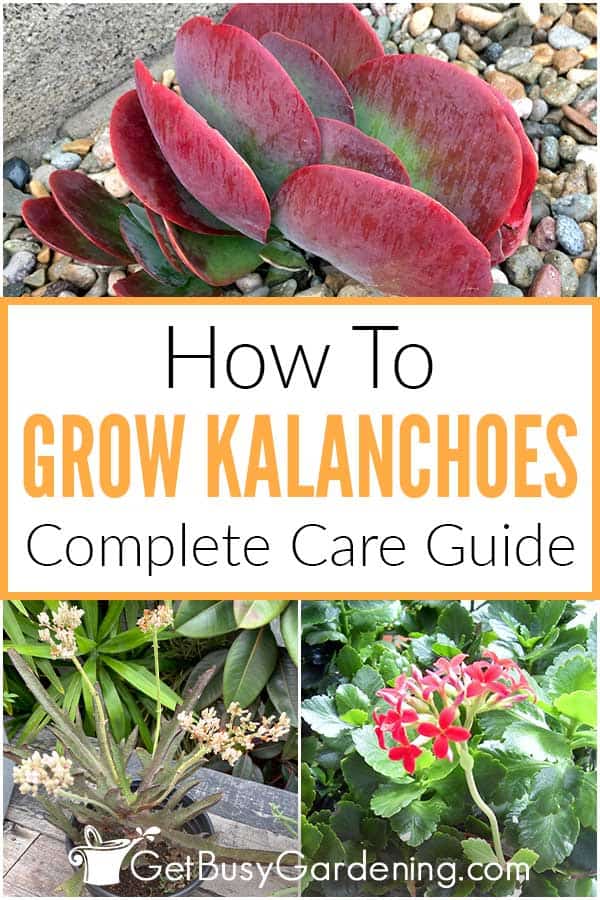
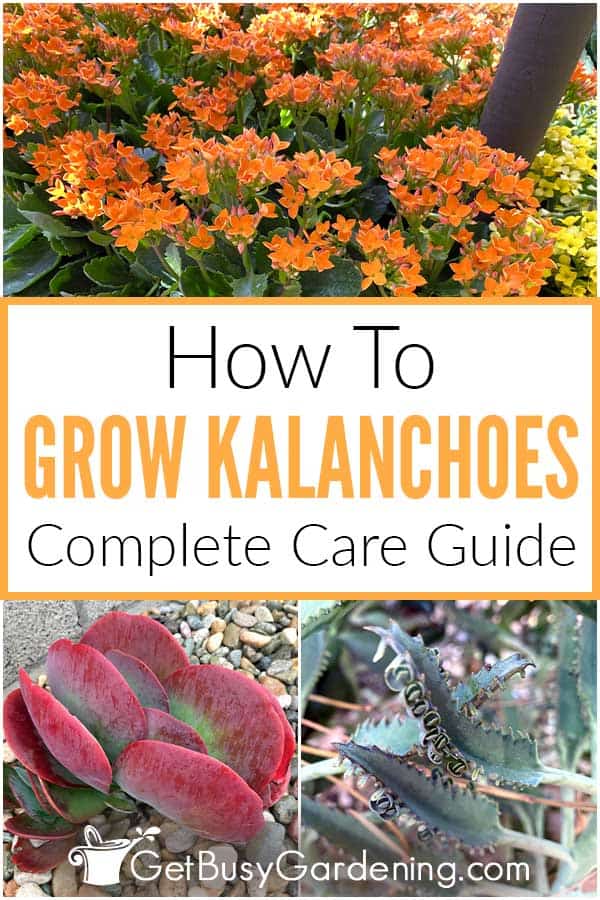
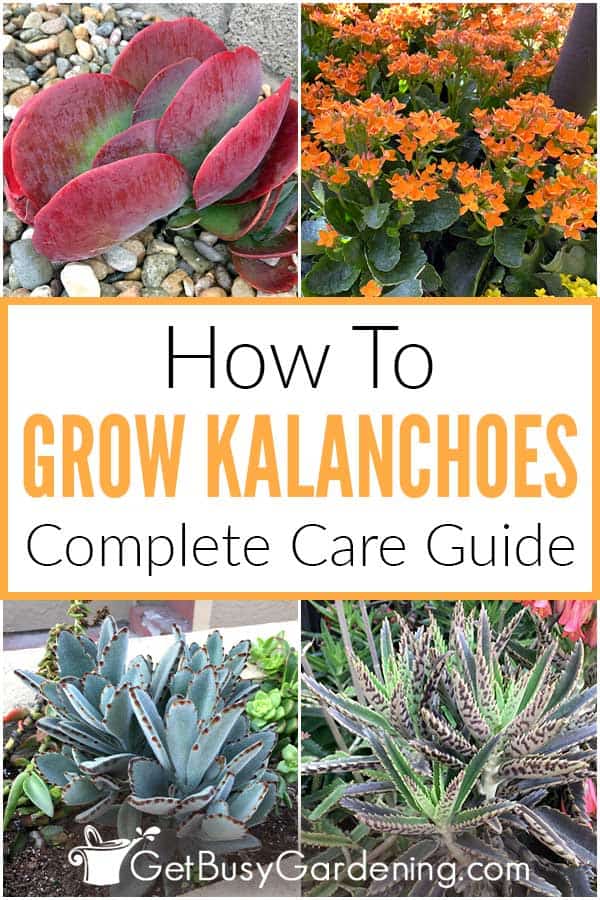



Sharon Lightcap says
I have a kalanchoe plant that over the years it’s stems have become very thick and look more like a tree branch. They are over a foot tall and have began to curl over because of their weight. What can I do to stableize them? I would hate to lose the plant. And the Second one I have has long draping stems and leaves where it looks more like a hanging plant. I am fairly new to this. Any help would be greatly appreciated.
Amy Andrychowicz says
It totally depends on which variety of kalanchoe plant you have. Some are short, while others are tall. Some will form tall flower stalks, while others are more compact. You can post photos on my Facebook page if you’d like, and I’ll take a look to see what the problem is.
Brenda Lane says
I have white spots all over my kalanchoes plant. What is this and how do I get rid of it. Don’t want to spread to other plants
Amy Andrychowicz says
Oh no, sorry to hear that your kalanchoe isn’t doing well. The white spots could be some kind of a bug, I’m guessing probably mealybugs. Here are a few articles that will help you figure it out and get rid of them…
Getting Rid of Mealybugs on Your Houseplants For Good
How To Identify Common Types Of Houseplant Bugs